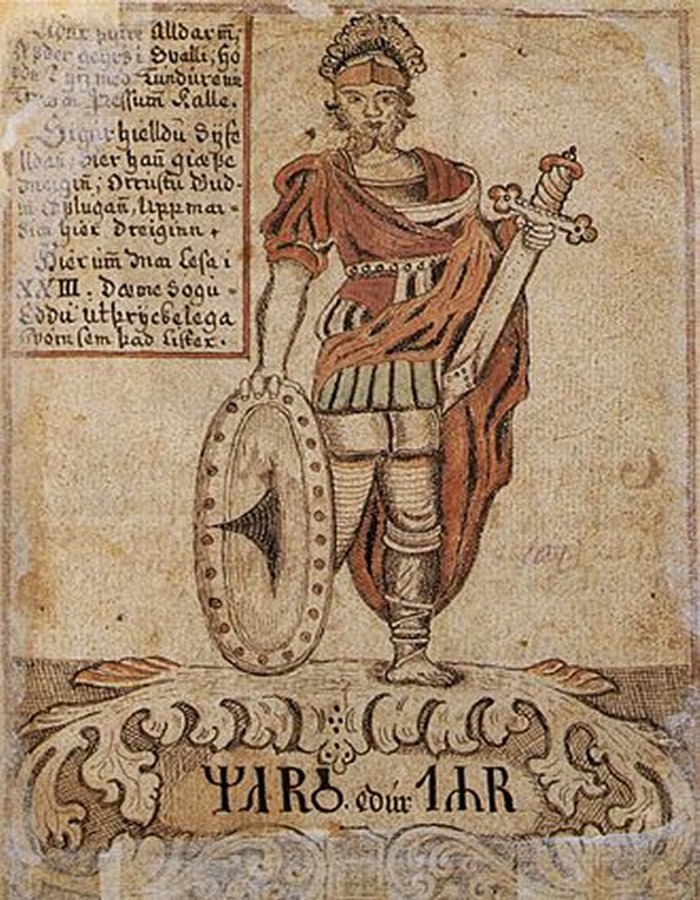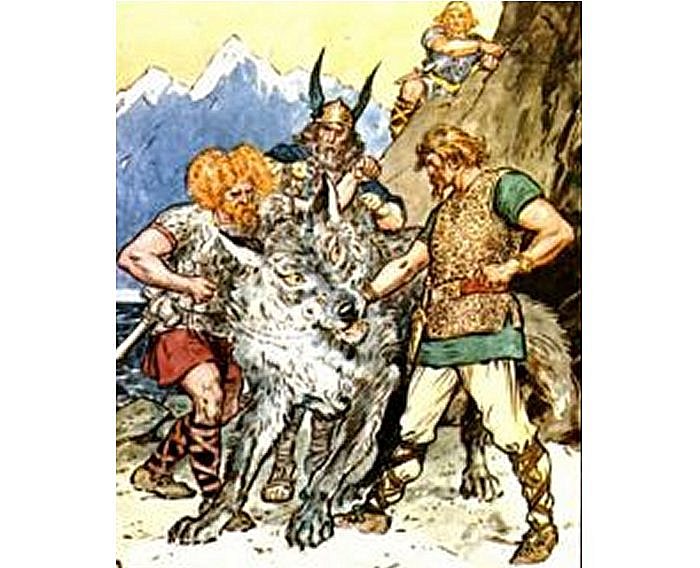Norse God Tyr Who Gave Viking Warriors Courage And Self-Confidence In Battle
A. Sutherland - AncientPages.com - At one time in the distant past, Tyr was a god of war and a sky god. He was concerned with justice and with reasonable and fair treaties.
There is a version according to which Tyr was the main god among the gods of Aesir, and he was their leader.
Týr equated with Mars in an 18th-century manuscript (ÍB 299 4to). Image uploader: Michelmfb - Public Domain
At the time, he might have been the leader of the Norse Pantheon, and his role was even more significant than Odin.
It was before Odin had become the undisputed chief of the gods. Later, his role as the chief god was significantly diminished. In some stories, he is the son of the giant Hymir, and in later Norse beliefs, when the myths were written down, Tyr was referred to as Odin's son and the patron of warriors.
He is associated with law and glory, and he embodies bravery.
Otherwise, little is known about him, and few traditions connected with him have survived.
Many researchers have unsuccessfully attributed to God Tyr different features in their assumptions. Tyr is a very complex and enigmatic figure in the Norse pantheon, and it is even uncertain whether Tyr was a forerunner of the god Odin; this combination is not mentioned in the Eddas and North mythical stories recorded by the 13th-century Icelandic poet Snorri Sturluson.
As to his bravery, this feature of the god Tyr is mentioned in the Icelandic Eddas. Tyr is considered the bravest of all the gods of Aesir because he is the only one who decides to put his hand into the jaws of the terrible wolf, Fenrir.
Image credit: Charles E Brock, 1930. Public Domain
Fenrir bit off Tyr's hand when the other gods broke their word to the beast and tied him up.
Therefore, most depictions of Tyr show him as the one-handed god.
According to the Poetic Edda and Prose Edda, the gods decided to chain the wolf Fenrir at one stage, but the beast broke every chain or rope they put upon him.
Finally, the dwarves made a magical silk ribbon called Gleipnir, but Fenrir sensed the gods' deceit and refused to be bound by it. He explained that Gleipnir was very thin, and there would be no fame for him if he tore such a delicate chain unless – one of the gods put his hand in the wolf's mouth.
No one dared to fulfill Fenrir's request except the brave Tyr. When the gods saw that Fenrir was bound, they celebrated, but Tyr did not do it.
He knew that Fenrir would remain bound until the day of Ragnarok.
Tyr has remained the most enigmatic figure in Norse mythology and is one of the important heroes of the Scandinavian epic. Both bravery and heroism are attributed to him. If a warrior carved a rune into his weapon, it became a weapon of Tyr's. It was believed that such a weapon significantly increased that warrior's chances of success in battle.
Numerous spears have been unearthed on which runic inscriptions say that these spears are "dedicated to the wise and brave Tyr."
Viking warriors used to call upon him in battle; he gave them courage and self-confidence. This god is remembered and surrounded with deep respect, and captains and princes are designated after him.
Written by – A. Sutherland AncientPages.com Staff Writer
Updated on November 23, 2023
Copyright © AncientPages.com All rights reserved. This material may not be published, broadcast, rewritten or redistributed in whole or part without the express written permission of AncientPages.com
Expand for referencesReferences:
Paul Watkins P. Thunder God
Viktor Rydberg V. Teutonic Mythology
More From Ancient Pages
-
 Human Footprints Dating Back 800,000 Years Discovered In Norfolk UK
Archaeology | Feb 7, 2014
Human Footprints Dating Back 800,000 Years Discovered In Norfolk UK
Archaeology | Feb 7, 2014 -
 Ancient Campfires Reveal A 50,000-Year-Old Grocer And Pharmacy In Australia
Archaeology | Apr 14, 2022
Ancient Campfires Reveal A 50,000-Year-Old Grocer And Pharmacy In Australia
Archaeology | Apr 14, 2022 -
 Tooth Analysis Reveal Nebraska Resembled A Dry Savanna 18 Million Years Ago
Archaeology | Jun 8, 2022
Tooth Analysis Reveal Nebraska Resembled A Dry Savanna 18 Million Years Ago
Archaeology | Jun 8, 2022 -
 Varggrottan: Mysterious ‘Wolf Cave’ Was Home To Neanderthals 130,000 Years Ago – Oldest Human Dwelling In Scandinavia
Featured Stories | May 15, 2023
Varggrottan: Mysterious ‘Wolf Cave’ Was Home To Neanderthals 130,000 Years Ago – Oldest Human Dwelling In Scandinavia
Featured Stories | May 15, 2023 -
 Yehasuri – Little People Of South Carolina Living In The Woods – Native Americans’ Version Of Leprechauns
Featured Stories | Feb 26, 2019
Yehasuri – Little People Of South Carolina Living In The Woods – Native Americans’ Version Of Leprechauns
Featured Stories | Feb 26, 2019 -
 Remarkable Complex Of Early Neolithic Monuments Discovered In Herefordshire, England
Archaeology | Jul 21, 2023
Remarkable Complex Of Early Neolithic Monuments Discovered In Herefordshire, England
Archaeology | Jul 21, 2023 -
 Mystery Of The Lost Underground City Of The Grand Canyon
Featured Stories | Nov 19, 2014
Mystery Of The Lost Underground City Of The Grand Canyon
Featured Stories | Nov 19, 2014 -
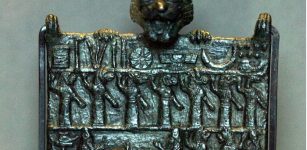 Lamashtu Plaque: Assyrian Healing Device Against The Evil Goddess
Artifacts | Mar 16, 2023
Lamashtu Plaque: Assyrian Healing Device Against The Evil Goddess
Artifacts | Mar 16, 2023 -
 Durendal – Magical Sword Of Knight Roland That Cut Stone Boulders With A Single Strike
Featured Stories | Jan 19, 2022
Durendal – Magical Sword Of Knight Roland That Cut Stone Boulders With A Single Strike
Featured Stories | Jan 19, 2022 -
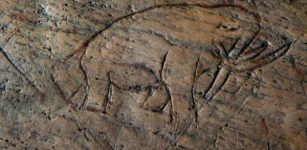 Controversial Study Of Ancient DNA Could Re-Write History Of South Florida And Prove Humans And Huge Prehistoric Animals Co-Existed
Archaeology | Sep 23, 2014
Controversial Study Of Ancient DNA Could Re-Write History Of South Florida And Prove Humans And Huge Prehistoric Animals Co-Existed
Archaeology | Sep 23, 2014 -
 Impressive 2,700-Year-Old Farmhouse And 1,500-Year-Old Monastery Uncovered In Rosh Ha-‘Ayin
Archaeology | Dec 30, 2015
Impressive 2,700-Year-Old Farmhouse And 1,500-Year-Old Monastery Uncovered In Rosh Ha-‘Ayin
Archaeology | Dec 30, 2015 -
 Which Came First: The Reptile Or The Egg?
Evolution | Jun 12, 2023
Which Came First: The Reptile Or The Egg?
Evolution | Jun 12, 2023 -
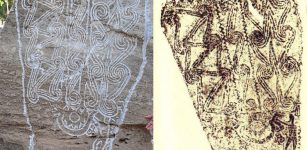 Bulgaria’s Reliefs From Ancient Thracian Sun Shrine – Restored
Artifacts | Sep 29, 2015
Bulgaria’s Reliefs From Ancient Thracian Sun Shrine – Restored
Artifacts | Sep 29, 2015 -
 Obscure History Of Atlantean Statues In Ancient Toltecs’ City Of Tula
Artifacts | Oct 19, 2020
Obscure History Of Atlantean Statues In Ancient Toltecs’ City Of Tula
Artifacts | Oct 19, 2020 -
 Ancient City Of Tyana And A 1600-Year-Old Rare Octagonal Church Unearthed In Central Anatolia Turkey
Archaeology | Aug 11, 2020
Ancient City Of Tyana And A 1600-Year-Old Rare Octagonal Church Unearthed In Central Anatolia Turkey
Archaeology | Aug 11, 2020 -
 Baby God Hermes Started His Life As A Liar And Trickster
Featured Stories | Dec 25, 2020
Baby God Hermes Started His Life As A Liar And Trickster
Featured Stories | Dec 25, 2020 -
 Manuscripts And Art Support Evidence That Syphilis Was In Europe Long Before Explorers Could Have Brought It Home
Featured Stories | Jul 15, 2022
Manuscripts And Art Support Evidence That Syphilis Was In Europe Long Before Explorers Could Have Brought It Home
Featured Stories | Jul 15, 2022 -
 Advent: Facts And History About The Christian Season Celebration
Christmas Traditions | Dec 1, 2024
Advent: Facts And History About The Christian Season Celebration
Christmas Traditions | Dec 1, 2024 -
 ‘Completely Unique’ Seal Matrix Found Near Norwich, UK
Archaeology | Dec 1, 2023
‘Completely Unique’ Seal Matrix Found Near Norwich, UK
Archaeology | Dec 1, 2023 -
 Queen Mama Ocllo: Legendary Wife Of Sapa Inca Manco Capac In Beliefs Of Andean People
Featured Stories | May 6, 2020
Queen Mama Ocllo: Legendary Wife Of Sapa Inca Manco Capac In Beliefs Of Andean People
Featured Stories | May 6, 2020

